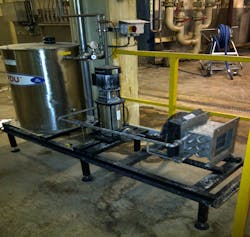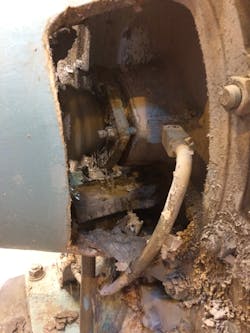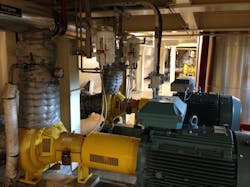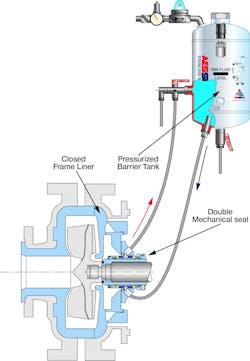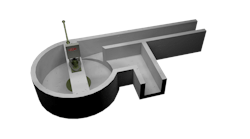Water conservation is an international imperative that companies across the industrial spectrum have allied themselves with, in principle if not yet entirely in practice.
Support for initiatives such as the National Water Reuse Action Plan (WRAP) show a willingness to seek sustainable operating methods. However, for companies negotiating other pressing concerns such as reducing downtime and optimizing productivity, it is easy to imagine how these might take precedence over environmental concerns in the ‘here and now’ of often 24/7 operations.
This conflict was highlighted by CDP, the global organization that drives action by companies and governments to safeguard water resources, in its 2018 report Treading Water. 1
It presented some stark facts: while the number of companies setting targets to reduce water withdrawals doubled between 2015 and 2018, in that same period there was an almost 50% rise in the number reporting higher water withdrawals, particularly in the manufacturing, food and beverage, and mineral extraction sectors.
It seems that what is needed is a strong incentive to convert a positive environmental ethos into action. This might be achieved by identifying where environmental gains can be made with minimum impact on the bottom line — and the pump sealing solutions employed on an industrial plant are a worthwhile place to start.
Identifying unnecessary wastage
There are two simple questions which will immediately identify potential hotspots for excessive water usage. Is your pump sealed with gland packing? And is your pump seal being flushed with water?
If you answer ‘yes’ to either of the above, it is highly likely that:
- Your plant is consuming excessive quantities of water.
- You are paying significant amounts on water management/effluent treatment.
- You have higher than necessary energy bills.
- You require frequent downtime for equipment repairs and replacement.
- You are losing costly product due to leakage.
Drawbacks of gland packing and single mechanical seals
Gland packing is based on the oldest principles of sealing: a compressed, lubricated material is tightly packed around the rotating pump shaft to achieve the most effective seal. The resulting friction creates a build-up of heat, so the packing must be flushed with large volumes of clean, cool water to prevent overheating and dry-running. This water is evaporated off or discarded (‘flush-to-drain’) at the end of each cycle.
Likewise, if you are using single mechanical seals on your pumps and use water rather than the process fluid to keep the seal faces cool and lubricated, this can prove equally intensive in terms of water consumption.
In a typical scenario, for example, where water is measured for one minute, around 6–12 liters (1.6–3.17 gallons) of flush water is required for each seal (or pump). In continuous operation that amounts to roughly 3.2–6.3 million liters (0.8–1.6 million gallons) per year.
With some industrial plants operating hundreds of pumps, it is not difficult to calculate how the energy costs of the heating, cooling and evaporation of flush water, or the management/effluent costs of discarding it, can mount up.
These sealing methods can also incur significant additional expenditure. Leakage is a standard feature of both, resulting in costly product loss and contamination.
The friction generated by gland packing requires more drive power, again requiring greater energy use. It also causes wear, both to the gland packing, which requires regular adjustment or replacement, and in worst case scenarios, to the pump shaft itself. Mean times between failure (MTBF) are often short and product loss, bearings failure, and regular stoppages for maintenance and repair can be so frequent that they are accepted as routine.
However, advanced sealing solutions are available that will reduce water wastage to virtually nil. They also offer quantifiable long-term benefits in terms of improved reliability and cost savings.
Improve reliability, reduce energy costs
A sealing solution comprising double mechanical seals will have an immediate impact on equipment reliability and energy use.
The optimum gland packing arrangement has a leakage rate of one drop per minute of sealed product per 25 mm of outside diameter shaft — so a 50 mm diameter shaft would see total leakage of 450 liters a month. By contrast, a well-designed, specified and fitted mechanical seal will lose the equivalent of half a teaspoon of product a day. For a product costing a dollar a liter, this would see an ROI on even an advanced mechanical seal of around six months.
With double mechanical seals, bearings are protected from damaging fluid ingress, which is one of the most common causes of failure and downtime, and the non-contacting seal design means pumps shafts are also protected. Further, the lack of friction means the power consumption of double mechanical seals is roughly six times less than that of gland packing.
However, these already significant advantages can be improved even further using a sustainable seal support system.
Water management for sustainability and savings
Wastage is as costly as it is inevitable when seal flush water is evaporated off or discarded at the end of a production cycle.
However, the most advanced seal support systems employ “continuous loop” water management systems. The system is connected directly to the plant water line, which becomes the system’s fluid and pressure source. The barrier fluid is supplied to the seal faces by thermosiphon, a method of passive heat exchange, providing a regulated, clean, lubricating film of fluid that protects the seal faces from harmful products. Water wastage is reduced to virtually nil.
This solution guarantees gains across the board.
Each seal operates to its maximum potential, increasing its reliability and lifespan and, by extension, that of the pump. MTBFs are increased, downtime reduced, and costs associated with excessive energy use and water management removed. A key sustainability goal is also achieved.
Case Study
A European-based sugar beet producer had a sustainability goal to reduce energy consumption by 50% by 2030. Its sugar refinery was using traditional gland packing to seal its juice circulation pumps, lubricating the seal faces with water to maximize the life of the packing, which leaked into the product and had to be evaporated off.
The seals were failing after roughly three campaigns due to leakage — an MTBF of little over a year. The packing also caused wear to the pump shaft sleeves, which had to be replaced.
AESSEAL replaced the packing with a dual mechanical seal and SW2 continuous loop water management system on 12 pumps. This remedied the leakage and shaft wear and removed the need to evaporate off seal water from the product.
With gland packing, based on the 12 pumps using 48 liters per hour, 24 hours per day in a 120-day campaign, water usage was measured at 1.68 million liters per campaign. This equated to 1,658 tons of return flow. To evaporate one ton of water required approximately 100 m3 of gas. Total gas usage to evaporate the injected seal water was therefore 165,888 m3.
Following the upgrade, the system operated without seal failure for eight years and led to the company extending the upgrade to 43 pumps, with significant impact on water and energy conservation.
This resulted in 5,000 m3 of water per year being saved and reduced gas usage by 594,432 m3/year — equivalent to an annual savings of around $240,000. The cost benefits of this upgrade are continuing year-on-year.
Double seal and water management systems can be retrofitted onto legacy equipment and are virtually maintenance-free. Considered alongside the financial savings and positive environmental impact, this merits careful consideration when weighing up the value of any potential investment in pump sealing solutions. WT
About the author: David Amory is global head of marketing for AESSEAL. The company recently achieved net zero carbon emissions in its UK operations and is on track to achieve global net zero in 2029. It has launched the Betterworld campaign to drive collective action to mitigate climate change across all industries.
Reference
1. Global Water Report 2018 - CDP ". 2021. Cdp.Net. https://www.cdp.net/en/research/global-reports/global-water-report-2018.
